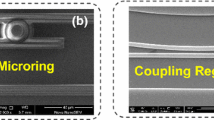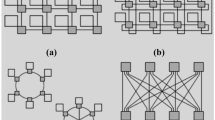Abstract
In this study, two-dimensional photonic structures (triangular, square, and honeycomb) are used to realise chip-to-chip communications in two ways. The transportation of signals from one chip to another is quite plausible because the lower potential value changes from 0.55 to 1.0 V. In this case, the operational mechanisms cope with the investigation of the photonic band gap analysis of the proposed crystal, which is prepared using the plane wave expansion technique. Apart from this, various types of losses such as propagation, diffraction, absorption, and scattering have also been investigated to realise the different efficiencies of the structures. These communications are envisaged through a laser diode (transmitter), photonic crystal structure (waveguide), and photo diode (receiver), which in turn act as a photonic integrated circuit. Here, 0.55 V, 0.62 V, 0.65 V, 0.68 V, 0.72 V, 0.75 V, 0.78 V, 0.8 V, 0.83 V, 0.86 V, 0.88 V, 0.90 V, 0.91 V, 0.92 V, 0.94 V, 0.95 V, 0.97 V, 0.98 V, and 1.0 V have been employed to realise an efficient optical VLSI device. The output result indicates that no loss is accomplished with the photonic integrated circuit, which infers efficient circuits for the exchange of signals from one electronic chip to another.







Similar content being viewed by others
Data availability
Not applicable.
References
Amiri, I.S., Palai, G., Alzubi, J.A., Ranjan Nayak, S.: Chip to chip communication through the photonic integrated circuit: a new paradigm to optical VLSI. Optik 202, 163588 (2020)
Aspnes, D.E., Studna, A.A.: Dielectric functions and optical parameters of Si, Ge, GaP, GaAs, GaSb, InP, InAs, and InSb from 15 to 60 eV. Phys. Rev. B 27, 985–1009 (1983)
Barker, A.S., Jr., Ilegems, M.: Infrared lattice vibrations and free-electron dispersion in GaN. Phys. Rev. B 7, 743–750 (1973)
Boobalan, S., Venkatesh Kumar, P., Vinoth Kumar, K., Palai, G.: Three ways chip to chip communication via a single photonic structure: a future paragon of 3D photonics to optical VLSI. IETE J. Res. (2021). https://doi.org/10.1080/03772063.2021.1908179
Castellano, J.A.: Liquid Gold: The Story of Liquid Crystal Displays and the Creation of an Industry, pp. 176–177. World Scientific (2005)
Choi, C.Q.: These optical gates offer electronic access ultrafast optical computing interfaces with traditional circuits; 16 Dec 2022; IEEE Spectrum (https://spectrum.ieee.org/optical-computing-picosecond-gates)
Grant, D.A., Gowar, J.: Power MOSFETS: Theory and Applications, p. 239. Wiley (1989)
Institute of Electrical and Electronics Engineers: The IEEE standard dictionary of electrical and electronics terms. 6th ed. New York, N.Y., Institute of Electrical and Electronics Engineers, c1997. IEEE Std 100-1996. ISBN 1-55937-833-6 [ed. Standards Coordinating Committee 10, Terms and Definitions; Jane Radatz, (chair)]
Jørgensen, A.A., et al.: Petabit-per-second data transmission using a chip-scale microcomb ring resonator source. Nat. Photon. 16, 798–802 (2022)
Maini, A.K.: Lasers and Optoelectronics. Wiley (2013)
Narasimha, A., Analui, B., Balmater, E., Clark, A., Gal, T., Guckenberger, D., Gutierrez, S., Harrison, M., Ingram, R., Koumans, R. and Kucharski, D., Leap, K., Liang, Y., Mekis, A., Mirsaidi, S., Peterson, M., Pham, T., Pinguet, T., Rines, D., Sadagopan, V., Sleboda, T.J., Song, D., Wang, Y., Welch, B., Witzens, J., Abdalla, S., Gloeckner, S., De Dobbelaere, P.: A 40-Gb/s QSFP optoelectronic transceiver in a 0.13 µm CMOS silicon-on-insulator technology. In: Proceedings of the optical fiber communication conference (OFC): OMK7. doi:https://doi.org/10.1109/OFC.2008.4528356. ISBN 978-1-55752-856-8 (2008)
Scheibenzuber, W.G., Schwarz, U.T., Sulmoni, L., Dorsaz, J., Carlin, J.F., Grandjean, N.: Recombination coefficients of GaN-based laser diodes. J. Appl. Phys. 109, 093106 (2011)
Schneider, F., Draheim, J., Kamberger, R., Wallrabe, U.: Process and material properties of polydimethylsiloxane (PDMS) for optical MEMS. Sens. Actuators A Phys. 151, 95–99 (2009)
Skauli, T., Kuo, P.S., Vodopyanov, K.L., Pinguet, T.J., Levi, O., Eyres, L.A., Harris, J.S., Fejer, M.M., Gerard, B., Becouarn, L., Lallier, E.: Improved dispersion relations for GaAs and applications to nonlinear optics. J. Appl. Phys. 94, 6447–6455 (2003)
Son, G., Han, S., Park, J., Kwon, K., Yu, K.: High-efficiency broadband light coupling between optical fibers and photonic integrated circuits. Nanophotonics 7(12), 1845–1864 (2018)
Sukhoivanov, I.A., Guryev, I.V.: Physics and Practical Modeling: Photonic Crystals. Springer, Heidelberg (2009)
Vijaya, M., Rangarajan, G.: Materials Science. Tata McGraw-Hill Education, NewDelhi (2003)
Yang, K.Y., et al.: Multi-dimensional data transmission using inverse-designed silicon photonics and microcombs. Nat. Commun. (2022). https://doi.org/10.1038/s41467-022-35446-4
Funding
Not applicable.
Author information
Authors and Affiliations
Contributions
Conceptualization and writing-original draft preparation, SAS; conceptualization and writing—review and editing, RN; Supervision and Methodology, SM.; software and validation, NS; methodology and visualization, SA.; analysis, writing—review and editing, JV; Investigation, writing—review and editing, PK; validation, resources and supervision, NRN; All authors reviewed the manuscript.
Corresponding author
Ethics declarations
Conflict of interest
The authors declare no conflict of interest.
Ethical approval
Not applicable.
Additional information
Publisher's Note
Springer Nature remains neutral with regard to jurisdictional claims in published maps and institutional affiliations.
Rights and permissions
Springer Nature or its licensor (e.g. a society or other partner) holds exclusive rights to this article under a publishing agreement with the author(s) or other rightsholder(s); author self-archiving of the accepted manuscript version of this article is solely governed by the terms of such publishing agreement and applicable law.
About this article
Cite this article
Sivakumar, S.A., Naveen, R., Ibrahim, S.J.A. et al. Two-ways chip to chip communications through 2-dimensional photonic structures via photonic integrated circuit. Opt Quant Electron 55, 661 (2023). https://doi.org/10.1007/s11082-023-04941-3
Received:
Accepted:
Published:
DOI: https://doi.org/10.1007/s11082-023-04941-3




